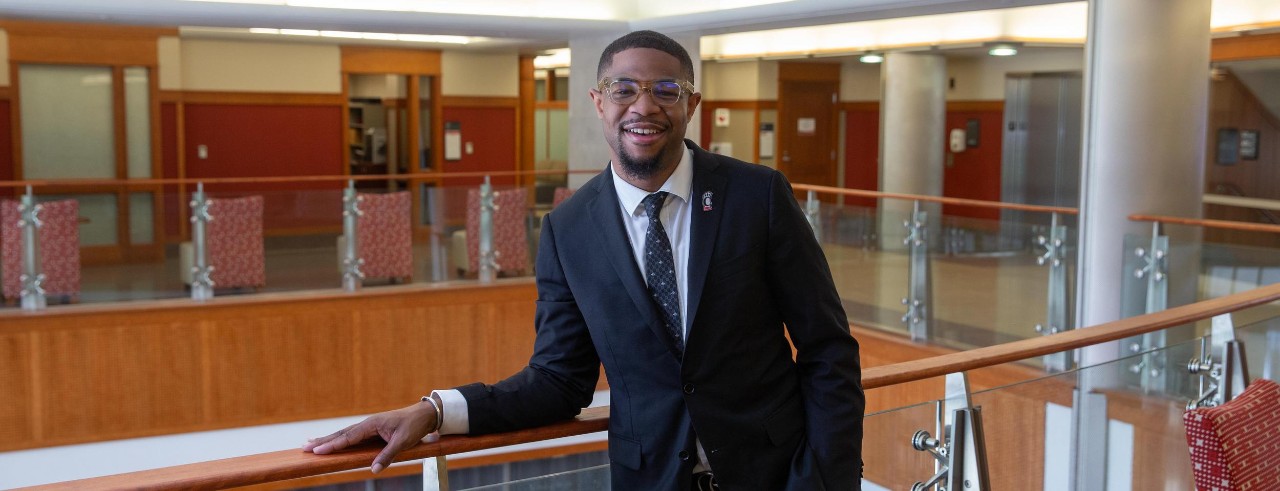
Many juvenile ‘lifers’ freed
UC criminologist and researchers compile study of persons under 18 sentenced to life without parole
In 1953, 15-year-old Joe Ligon and four other Pennsylvania teens went on an alcohol-fueled tear that resulted in the stabbing deaths of two people and injuries to six more.
The teens were tried as a group, and all received life without parole.
After a series of U.S. Supreme Court decisions in 2012 and 2016 found that mandatory life sentences for juveniles was unconstitutional, Ligon’s case went to federal court. After 67 long years in prison, the case was decided in his favor in 2020.
Ligon was granted his freedom in 2021 — at 83 years of age and after nearly seven decades behind bars. Soon after his release, J.Z. Bennett, a University of Cincinnati professor, criminologist and champion of criminal justice reform, got the chance to meet Ligon.

Joe Ligon (left) and UC criminologist J.Z. Bennett meeting after Ligon's release from prison in 2021. Ligon was sentenced to live without parole when he was 15 years old. Photo provided by Bennett.
“Meeting Joe Ligon showed me how we have ignored this group of children, primarily Black children, sentenced to life without parole and treated them as outcasts in this country through their long-term incarceration,” says Bennett, an assistant professor of criminology at UC’s College of Education, Criminal Justice, and Human Services (CECH).
“We need to think about second chances for adults who were sentenced as children. To punish someone for life for what they did at 12 or 15 years old is stark,” he said.
According to Bennett, lead author on a journal article published in the Journal of Criminal Justice, there are 2,904 juvenile “lifers” (as they are called) spread across the U.S. penal system, ranging in age from 19 to 70 (the average age being 45) and a significant number were 13 or 14 at the time of the offense.
"This is groundbreaking data as it is the first time academic literature provides a national overview of this population,” says Bennett.
The journal article, he says, provides insight into a full demographic profile of the juvenile life without parole population. It is based on a three-year study conducted by Bennett and co-investigators at the University of California and Temple University. The study examined key outcomes such as resentencing, release statuses, mortality and exonerations.
We are just scratching the surface of what it means to provide equitable decarceration...
J.Z. Bennett UC assistant professor of criminology
Since the Supreme Court rulings, more than 2,500 individuals have been resentenced and more than 1,000 of those have been released, the research team found. Approximately 400 await resentencing.
The open-access extensive national study explored young people who are ultimately given a chance at freedom after having been sentenced to life in prison.
“Given the gravity of this issue and this being the first national analysis, we are just scratching the surface of what it means to provide equitable decarceration efforts for individuals with long sentences,” says Bennett.
Additionally, he says the research underscores that the U.S. is unique among developed nations in sentencing minors to life without parole. Bennett believes that practice conflicts with international human rights standards, such as those outlined in Article 37 of the United Nations Convention on the Rights of the Child.

J.Z. Bennett in his office on the University of Cincinnati campus. Bennett worked with researchers across the country to gather national data on juveniles who are serving life sentences without parole. Photo/Andrew Higley/UC Marketing + Brand.
“Substantial disparities [exist] among states in how they handle the resentencing and release of individuals sentenced to juvenile life without parole,” he says. For example, California has resentenced nearly all eligible individuals, while Alabama and North Carolina have much lower rates of resentencing and subsequent release.
The article notes the numerous challenges faced by juvenile lifers upon release, including limited access to housing and employment, health issues and the difficulties of adjusting to a society that has changed significantly during their incarceration.
There is a need for reexamining all “lifer” cases and providing comprehensive support systems where successful reintegration is emphasized, says Bennett.
As in the case of Ligon who served 68 years, “for the first time, men and women who were sentenced as children are returning to society, some after serving 30, 40 and even over 50 years.”
Feature image at top of J.Z. Bennett. Photo/Andrew Higley/UC Marketing + Brand.
Impact Lives Here
The University of Cincinnati is leading public urban universities into a new era of innovation and impact. Our faculty, staff and students are saving lives, changing outcomes and bending the future in our city's direction. Next Lives Here.
Related Stories
UC researchers to study overdose hot spots in Cincinnati
January 14, 2025
A federally funded study by UC criminal justice researchers and the Hamilton County Office of Addiction Response is taking a new approach to help combat the growing overdose crisis in the region.
Youth placed in adult prison have their lives cut shorter, study says
July 27, 2023
A University of Cincinnati co-authored study found that in the U.S. youth who are incarcerated in adult correctional facilities are at a 33% higher risk for an early death between the ages of 18 and 39. The study, published in JAMA Open Network, also found that formal encounters with the legal system put youth at risk for a shorter lifespan during those same years.
WVXU: Youth placed in adult prisons are more likely to die early, study says
August 4, 2023
Criminal justice researcher Joseph Nedelec speaks to WVXU regarding new study of youth and longevity and the legal system. Nedelec is an associate professor in the UC School of Criminal Justice and co-led a study which found youth die earlier when they are placed in adult prisons.
